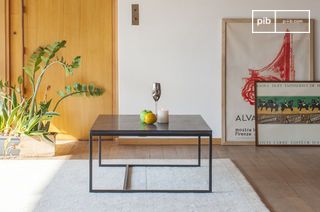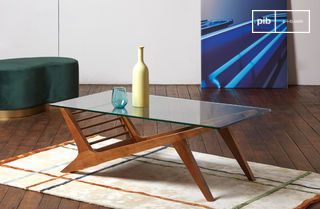Designer coffee tables
The designer coffee tables blend into the center of the living room like structuring volumes. Their lines are clean, crafted to dialogue with the rest of the furniture without formal redundancy. Whether it's a graphic base, a contrast of materials or a play on proportions, each design coffee table defines a focal point without overload. Their role is not decorative but spatial: to organize, articulate, punctuate. These are pieces designed to exist within a thoughtful whole.
read more >Filters

Black marble coffee tableAvedore
€495 €445-10%

Function and visual impact of a design coffee table
A design coffee table fulfills a function of articulation in the heart of the living room. It is not thought of as a simple support, but as a defined, visible volume that dialogues with the rest of the furnishings. Through its lines, materials and proportions, it guides the perception of space. Its primary function as a supporting surface remains present, but it doubles up as a formal balancing act: rupture, continuity or anchoring, as the case may be.
The particularity of a so-called design model lies in the coherence of its formal choices. A designer coffee table is often chosen to clarify the structure of the living room, whether by emphasizing an existing geometry or introducing a useful visual tension.
Materials, shapes and compositions
The diversity of materials used in designer coffee tables reflects their structural role. Folded metal, tempered glass, solid wood or stone are combined to produce effects of contrast, transparency or density. A slender steel base can support a solid travertine top. A solid structure, on the other hand, can be lightened by the inclusion of glass or the interplay of openings. Each composition generates a specific visual weight, to be adapted to the available surface and the overall legibility of the room.
The shapes often break away from orthogonal standards: stretched ovals, trapezoids, asymmetrical modules or nested compositions. This variety makes it possible to play with circulation, create controlled breaks or optimize use according to configuration. In some cases, several small-format designer tables can be combined instead of a single model, to segment the space or multiply functions (rest, presentation, storage).
Aggregation in space and overall coherence
Inserting a designer coffee table into a living room requires thoughtful consideration of all the volumes present. The model chosen must fit into a logic of continuity or contrast with the seats, floor, light fittings or walls. An angular model can reinforce the rigor of a structured space. An organic model can soften a very linear environment. The role of the table is to punctuate the space, without weighing it down.
Circulation around the piece of furniture must be preserved. A distance of 40 to 50 cm between the table and the seats ensures comfortable use. The choice of a thin top, an open base or a two-tier composition can facilitate insertion into medium-sized rooms. Design is not an end in itself: it must serve the legibility and coherence of the space.
Opting for a designer coffee table means choosing an element that engages the reading of the space. Every detail - height, thickness, inclination, void - produces a perceptible effect. So it's best to think of this piece as a spatial landmark, capable of structuring without dominating, singling out without unbalancing.
